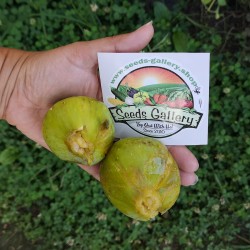Menu
-
MenuBack
- Home
-
Categories
-
-
Categories
-
Vegetable Seeds
-
Varieties by Country
- Varieties from Armenia
- Varieties from BiH
- Varieties from Croatia
- Varieties from France
- Varieties from Germany
- Varieties from Greece
- Varieties from Hungary
- Varieties from India
- Varieties from Italy
- Varieties from Japan
- Varieties from North Macedonia
- Varieties from Peru
- Varieties from Russia
- Varieties from Serbia
- Varieties from Slovenia
- Varieties from Spain
- Varieties from Thailand
- Varieties from Turkey
- Varieties from USA
- Tomato Seeds
- Corn Seeds
- Gourd family
- Bean family
- Cucumber Seeds
- Pepper Seeds
- Carrot family
- Onion family
- Lettuce Seeds
- Potato family
- Cabbage family
- Radish Seeds
- Beetroot family
- Watermelon Seeds
- Melon Seeds
- Cauliflower Seeds
- Sunflower family
-
Varieties by Country
- Fruit Seeds
- Chili - Habanero Seeds
- Medicinal Herb Seeds
- Climbing Plants Seeds
- Trees Bonsai Seeds
- Palm Seeds
- Ornamental Grasses Seeds
- Tobacco Seeds
-
Vegetable Seeds
-
-
-
-
- NEW PRODUCTS
- Create account
- Delivery - Payment
- FAQ
Last Product Reviews
These peppers came all the way from eastern Europe and took a while at no f...
By
 Fitim Berani on 21/09/2023
Fitim Berani on 21/09/2023
Verified Purchase
Last customers
- Stef, Waalwijk, Netherlands
- CORINNE, NOTRE DAME DE LONDRES, France
- Dušan, KRAVANY NAD DUNAJOM, Slovakia
- Arno, Ehrenkirchen, Germany
- Costas, LARNACA , Cyprus
- Fulvio francesco, Santa Domenica Talao, Italy
- william, Dun, France
- Aymeric , Saint tricat, France
- Ricard, Sant Celoni, Spain
- Maureen, Enniscorthy Co Wexford , Ireland
- Paul, St. Vigil in Enneberg (BZ), Italy
- Ricardo jorge , Viseu , Portugal
- Radosav, Kragujevac, Serbia
- Sylvie, Neyruz, Switzerland
- Julien, Scionzier, France
- Zoran, Vinca, Serbia
- Josef, Hochdorf-Assenheim, Germany
- Davide, London, United Kingdom
- Kimberly, Victoria, Gozo, Malta
- Saša , Beograd, Serbia
- Ewa, Galway, Ireland
- Ioannis , Kato Achaia, Greece
- Samuele, Milano, Italy
- Dubravka, Niš , Serbia
- Theodoros, Grevena, Greece
- goderis, bredene, Belgium
- Vickie, SARONA, United States
- Maria, ÓBIDOS / LEIRIA, Portugal
- Emmanuel, Dijon, France
- Henri , Koumac, New Caledonia
There are 378 products.
Showing 301-312 of 378 item(s)
.png)
Variety from Greece

This plant has giant fruits
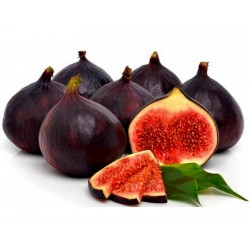
Royal Black Greek Fig Seeds...
Price
€2.15
SKU: V 19 RBG
Seeds Gallery Com,
5/
5
<h2><strong>Royal Black Greek Fig Seeds - Vasilika Mavra (Βασιλικά Μαύρα)</strong></h2>
<h2><span style="color: #ff0000;" class=""><strong>Price for Package of 50 (0,02g) seeds.</strong></span></h2>
<p>Vasilika Mavra or the "Royal Black Greek Fig" is said to be the best tasting of the Greek figs. It is widely grown in Greece. The outside is very dark purple to black and the inside is red.</p>
<p>Our experience has been after a couple of years of growing this variety is that Vasilika Mavra produces many very nice dark purple figs that have dropped before they were mature inside. The size, depth of color, and number have grown year over year for us. We hope as the mother trees mature the figs will hold as other varieties have.</p>
<p>Those fortunate enough to have tried this fig describe it as berry and honey flavored, thick and jammy.</p>
<p>Vasilika Mavra produces super sweet “figs” that continues to the end of the season.</p>
<p>Other names: Royal Black Greek Fig, Βασιλικά Μαύρα,</p><script src="//cdn.public.n1ed.com/G3OMDFLT/widgets.js"></script>
V 19 RBG (0,02g)

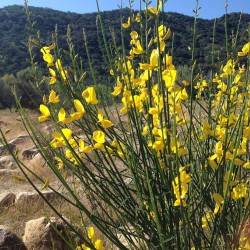
Spanish broom Seeds...
Price
€1.75
SKU: T 85
Seeds Gallery Com,
5/
5
<meta http-equiv="Content-Type" content="text/html; charset=UTF-8" />
<h2><strong>Spanish broom Seeds (Spartium junceum)</strong></h2>
<h2><span style="color: #ff0000;"><strong>Price for Package of 10 seeds.</strong></span></h2>
<p>Spartium junceum, the Spanish broom, rush broom, or weaver's broom, is a species of flowering plant in the family Fabaceae.</p>
<p>It is the sole species in the genus Spartium, but is closely related to the other brooms in the genera Cytisus and Genista. There are many binomials in Spartium that are of dubious validity (see below).</p>
<p>The Latin specific epithet junceum means "rush-like", referring to the shoots, which show a passing resemblance to those of the rush genus Juncus.</p>
<p>Distribution and habitat<br />This species is native to the Mediterranean in southern Europe, southwest Asia, and northwest Africa, where it is found in sunny sites, usually on dry, sandy soils.</p>
<p>Description<br />S. junceum is a vigorous, deciduous shrub growing to 2–4 m (7–13 ft) tall, rarely 5 m (16 ft), with main stems up to 5 cm (2 in) thick, rarely 10 cm (4 in). It has thick, somewhat succulent grey-green rush-like shoots with very sparse small deciduous leaves 1 to 3 cm long and up to 4 mm broad. The leaves are of little importance to the plant, with much of the photosynthesis occurring in the green shoots (a water-conserving strategy in its dry climate). The leaves fall away early.[9] In late spring and summer shoots are covered in profuse fragrant yellow pea-like flowers 1 to 2 cm across. In late summer, the legumes (seed pods) mature black and reach 8–10 cm (3–4 in) long. They burst open, often with an audible crack, spreading seed from the parent plant.</p>
<p>Invasive species<br />Spartium junceum has been widely introduced into other areas and is regarded as a noxious invasive species in places with a Mediterranean climate such as California and Oregon, Hawaii, central Chile, southeastern Australia, the Western Cape in South Africa and the Canary Islands and Azores. It was first introduced to California as an ornamental plant.</p>
<p><strong>Uses</strong><br />The plant is used as an ornamental plant in gardens and in landscape plantings. It has gained the Royal Horticultural Society's Award of Garden Merit.</p>
<p>In Bolivia and Peru, the plant is known as retama, (not to be confused with the genus Retama), and has become very well established in some areas. It is one of the most common ornamental plants, often seen growing along sidewalks in La Paz.</p>
<p>Retama has made its way into the ethnobotany of the indigenous Aymara and Quechua cultures.</p>
<p>The plant is also used as a flavoring, and for its essential oil, known as genetic absolute. Its fibers have been used for cloth and it produces a yellow dye.</p>
T 85 (10 S)

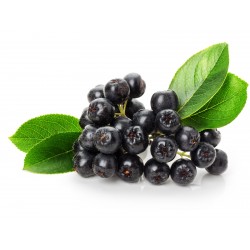
Chokeberry Seeds (Aronia...
Price
€1.95
SKU: V 29
Seeds Gallery Com,
5/
5
<h2><strong>Chokeberry Seeds (Aronia melanocarpa)</strong></h2>
<h2><span style="color: #ff0000;" class=""><strong>Price for Package of 150 seeds.</strong></span></h2>
<p style="color: #202122; font-size: 14px;"><i><b>Aronia</b></i><span> </span>is a genus of<span> </span>deciduous<span> </span>shrubs, the<span> </span><b>chokeberries</b>, in the family<span> </span>Rosaceae<span> </span>native to eastern North America and most commonly found in wet woods and swamps.<span> </span>The genus is usually considered to contain two<span> </span>or three<span> </span>species, one of which is<span> </span>naturalized<span> </span>in Europe.<sup id="cite_ref-7" class="reference" style="font-size: 11.2px;"></sup><span> </span>A fourth form that has long been cultivated under the name<span> </span><i>Aronia</i><span> </span>is now considered to be an<span> </span>intergeneric hybrid,<span> </span><i>× Sorbaronia mitschurinii</i>.</p>
<p style="color: #202122; font-size: 14px;">Chokeberries are cultivated as<span> </span>ornamental plants<span> </span>and as<span> </span>food products. The sour berries, or<span> </span><b>aronia berries</b>, can be eaten raw off the bush, but are more frequently processed. They can be found in wine, jam, syrup, juice, soft spreads, tea, salsa, extracts, beer, ice cream,<span> </span>gummies, and<span> </span>tinctures.<sup id="cite_ref-Iowa_State_8-0" class="reference" style="font-size: 11.2px;"></sup><span> </span>The name "chokeberry" comes from the<span> </span>astringency<span> </span>of the fruits, which create the sensation of making one's mouth pucker.</p>
<p style="color: #202122; font-size: 14px;">Chokeberries are often mistakenly called<span> </span>chokecherries, the<span> </span>common name<span> </span>for<span> </span><i>Prunus virginiana</i>. Further adding to the ambiguity, a<span> </span>variety<span> </span>of<span> </span><i>Prunus virginiana</i><span> </span>is<span> </span><i>melanocarpa</i>,<sup id="cite_ref-9" class="reference" style="font-size: 11.2px;"></sup><span> </span>and readily confused with black chokeberry because it is commonly referred to as "black chokeberry" or "aronia". Aronia berries and chokecherries both contain<span> </span>polyphenolic<span> </span>compounds, such as<span> </span>anthocyanins, yet the two plants are only distantly related within the Rosaceae.</p>
<h2 style="color: #000000; font-size: 1.5em;"><span class="mw-headline" id="Identification_and_taxonomy">Identification and taxonomy</span></h2>
<p>The<span> </span>leaves<span> </span>are alternate, simple, and<span> </span>oblanceolate<span> </span>with<span> </span>crenate<span> </span>margins and<span> </span>pinnate<span> </span>venation; in autumn, the leaves turn a bold red color. Dark<span> </span>trichomes<span> </span>are present on the upper midrib surface. The<span> </span>flowers<span> </span>are small, with five<span> </span>petals<span> </span>and five<span> </span>sepals, and produced in<span> </span>corymbs<span> </span>of 10–25 together. The<span> </span>hypanthium<span> </span>is urn-shaped. The fruit is a small<span> </span>pome, with an<span> </span>astringent<span> </span>flavor.</p>
<p><i>Aronia</i><span> </span>has been thought to be closely related to<span> </span><i>Photinia</i>, and has been included in that genus in some classifications,<sup id="cite_ref-10" class="reference" style="font-size: 11.2px;"></sup><span> </span>but botanist Cornelis Kalkman observed that a combined genus should be under the older name<span> </span><i>Aronia</i>.<sup id="cite_ref-Kalkman_11-0" class="reference" style="font-size: 11.2px;"></sup><span> </span>The combined genus contains about 65 species.<sup id="cite_ref-weakley_12-0" class="reference" style="font-size: 11.2px;"></sup><span> </span>In 2004, Kalkman expressed doubt about the<span> </span>monophyly<span> </span>of the combined group, and new molecular studies confirm this.<sup id="cite_ref-Potter_13-0" class="reference" style="font-size: 11.2px;"></sup><sup id="cite_ref-Campbell_14-0" class="reference" style="font-size: 11.2px;"></sup><span> </span>They do not place these two genera together or even near one another.</p>
<p>In eastern North America, two well-known species are named after their fruit color, red chokeberry and black chokeberry, plus a purple chokeberry whose origin is a natural hybrid of the two.<sup id="cite_ref-weakley_12-1" class="reference" style="font-size: 11.2px;"></sup><span> </span>A fourth species,<span> </span><i>Aronia mitschurinii</i>, that apparently originated in cultivation, is also known as<span> </span><i>Sorbaronia mitschurinii</i>.<br /><span style="color: #202122; font-size: 14px;"><br />Tends to be smaller, rarely exceeding 1 m (3ft) tall and 3 m (9.8ft) wide, and spreads readily by root sprouts. The leaves are smaller, not more than 6-cm wide, with terminal glands on leaf teeth and a glabrous underside. The flowers are white, 1.5 cm wide, with glabrous sepals. The fruit is black, 6–9 mm wide, not persisting into winter.<br /></span></p>
<h2 style="color: #000000; font-size: 1.5em;"><span class="mw-headline" id="Cultivation">Cultivation</span></h2>
<p><i>Aronia</i><span> </span>is considered cold-hardy and heat tolerant in<span> </span>USDA<span> </span>zones 3 to 8.<sup id="cite_ref-usda_17-0" class="reference" style="font-size: 11.2px;"></sup><sup id="cite_ref-18" class="reference" style="font-size: 11.2px;"></sup><span> </span>Aronia plants grow well both in<span> </span>orchard-type rows or set as<span> </span>landscape<span> </span>elements, including several varieties in 3 to 12-foot heights.</p>
<h2 style="color: #000000; font-size: 1.5em;"><span class="mw-headline" id="Products_and_uses">Products and uses</span></h2>
<p>The chokeberries are attractive<span> </span>ornamental plants<span> </span>for gardens. They are naturally understory and woodland edge plants, and grow well when planted under<span> </span>trees. Chokeberries are resistant to drought, insects, pollution, and disease. A number of<span> </span>cultivars, including<span> </span><i>A. arbutifolia</i><span> </span>'Brilliant' and<span> </span><i>A. melanocarpa</i><span> </span>'Autumn magic', have been selected for their striking fall leaf color.</p>
<p>An aronia wine is made in<span> </span>Lithuania<span> </span>and Minnesota. In<span> </span>Poland, aronia berries are added to jams and juices or dried to make a herbal<span> </span>tea<span> </span>sometimes blended with other ingredients, such as<span> </span>blackcurrant.<sup id="cite_ref-mckay_19-0" class="reference" style="font-size: 11.2px;">[19]</sup><span> </span>In<span> </span>Bosnia and Herzegovina, the berries are sold fresh and frozen or made into juices, jams and teas.<sup id="cite_ref-Fresh_Fruit_Portal_20-0" class="reference" style="font-size: 11.2px;"></sup><span> </span>Aronia is also used as a<span> </span>flavoring<span> </span>or<span> </span>colorant<span> </span>for beverages or yogurts.<sup id="cite_ref-mckay_19-1" class="reference" style="font-size: 11.2px;">[19]</sup><span> </span>Juice from the ripe berries is<span> </span>astringent, semi-sweet (moderate sugar content), sour (low<span> </span>pH), and contains a low level of<span> </span>vitamin C.<sup id="cite_ref-21" class="reference" style="font-size: 11.2px;"></sup><span> </span>The berries have a tart<span> </span>flavor<span> </span>and, in addition to juice, can be baked into breads.<sup id="cite_ref-mckay_19-2" class="reference" style="font-size: 11.2px;">[19]</sup><span> </span>In the United States and Canada, aronia<span> </span>juice concentrate<span> </span>is used in manufactured juice blends.</p>
<h3 style="color: #000000; font-size: 1.2em;"><span class="mw-headline" id="Polyphenol_content">Polyphenol content</span></h3>
<p><i>A. melanocarpa</i><span> </span>(black chokeberry) has attracted scientific interest due to its deep purple, almost black<span> </span>pigmentation<span> </span>that arises from dense contents of<span> </span>polyphenols, especially<span> </span>anthocyanins. Total polyphenol content is 1752 mg per 100 g dry weight,<sup id="cite_ref-Phenol-Explorer_22-0" class="reference" style="font-size: 11.2px;">[22]</sup><span> </span>anthocyanin content is 1480 mg per 100 g dry weight, and<span> </span>proanthocyanidin<span> </span>concentration is 664 mg per 100 g fresh weight.<sup id="cite_ref-Wu_23-0" class="reference" style="font-size: 11.2px;">[23]</sup><sup id="cite_ref-24" class="reference" style="font-size: 11.2px;">[24]</sup><span> </span>These values are among the highest measured in plants to date. The black aronia species contains higher levels of anthocyanins than purple (<i>Aronia prunifolia</i>) or red aronia (<i>Aronia arbutifolia</i>), whereas red and purple aronia are richer in phenolic acid and proanthocyanins.</p>
<p>The plant produces these pigments mainly in the leaves and skin of the berries to protect the pulp and seeds from constant exposure to<span> </span>ultraviolet radiation<span> </span>and production of<span> </span>free radicals.<sup id="cite_ref-simon_26-0" class="reference" style="font-size: 11.2px;">[26]</sup><sup id="cite_ref-27" class="reference" style="font-size: 11.2px;">[27]</sup><sup id="cite_ref-28" class="reference" style="font-size: 11.2px;">[28]</sup><span> </span>By absorbing<span> </span>UV<span> </span>rays in the<span> </span>blue-purple spectrum, leaf and skin pigments filter intense sunlight, serve antioxidant functions and thereby have a role assuring regeneration of the species. Brightly colorful pigmentation also attracts birds and other animals to consume the fruit and disperse the seeds in their droppings.<sup id="cite_ref-simon_26-1" class="reference" style="font-size: 11.2px;"></sup><sup id="cite_ref-29" class="reference" style="font-size: 11.2px;"></sup></p>
<p>Analysis of polyphenols in chokeberries has identified the following individual chemicals (among hundreds known to exist in the plant kingdom):<span> </span>cyanidin-3-galactoside, cyanidin-3-arabinoside,<span> </span>quercetin-3-glycoside,<span> </span>epicatechin,<span> </span>caffeic acid,<span> </span>delphinidin,<span> </span>petunidin,<span> </span>pelargonidin,<span> </span>peonidin, and<span> </span>malvidin.<sup id="cite_ref-Wu_23-1" class="reference" style="font-size: 11.2px;"></sup><sup id="cite_ref-pmid23941506_25-1" class="reference" style="font-size: 11.2px;"></sup><sup id="cite_ref-30" class="reference" style="font-size: 11.2px;"></sup><span> </span>All these except caffeic acid are members of the<span> </span>flavonoid<span> </span>category of phenolics.</p>
<p>For reference to phenolics, flavonoids, anthocyanins, and similar plant-derived phytochemicals,<sup id="cite_ref-Phenol-Explorer_22-1" class="reference" style="font-size: 11.2px;"></sup><span> </span>Wikipedia has a<span> </span>list of phytochemicals and foods in which they are prominent.</p>
<p><span style="color: #202122; font-size: 14px;"></span><br /><br /></p>
<div>
<table border="1" cellspacing="0" cellpadding="0">
<tbody>
<tr>
<td colspan="2" valign="top" width="100%">
<p><span style="color: #008000;"><strong>Sowing Instructions</strong></span></p>
</td>
</tr>
<tr>
<td valign="top" nowrap="nowrap">
<p><span style="color: #008000;"><strong>Propagation:</strong></span></p>
</td>
<td valign="top">
<p><span style="color: #008000;">Seeds</span></p>
</td>
</tr>
<tr>
<td valign="top" nowrap="nowrap">
<p><span style="color: #008000;"><strong>Pretreat:</strong></span></p>
</td>
<td valign="top">
<p><span style="color: #008000;">soak in water for 8- 12 hours </span></p>
</td>
</tr>
<tr>
<td valign="top" nowrap="nowrap">
<p><span style="color: #008000;"><strong>Stratification:</strong></span></p>
</td>
<td valign="top">
<p><span style="color: #008000;">1 months in moist sowing mix at 2-5 ° C refrigerator</span></p>
</td>
</tr>
<tr>
<td valign="top" nowrap="nowrap">
<p><span style="color: #008000;"><strong>Sowing Time:</strong></span></p>
</td>
<td valign="top">
<p><span style="color: #008000;">all year round</span></p>
</td>
</tr>
<tr>
<td valign="top" nowrap="nowrap">
<p><span style="color: #008000;"><strong>Sowing Depth:</strong></span></p>
</td>
<td valign="top">
<p><span style="color: #008000;">1 cm</span></p>
</td>
</tr>
<tr>
<td valign="top" nowrap="nowrap">
<p><span style="color: #008000;"><strong>Sowing Mix:</strong></span></p>
</td>
<td valign="top">
<p><span style="color: #008000;">Coir or sowing mix + sand or perlite</span></p>
</td>
</tr>
<tr>
<td valign="top" nowrap="nowrap">
<p><span style="color: #008000;"><strong>Germination temperature:</strong></span></p>
</td>
<td valign="top">
<p><span style="color: #008000;">20 ° C</span></p>
</td>
</tr>
<tr>
<td valign="top" nowrap="nowrap">
<p><span style="color: #008000;"><strong>Location:</strong></span></p>
</td>
<td valign="top">
<p><span style="color: #008000;">bright + keep constantly moist not wet</span></p>
</td>
</tr>
<tr>
<td valign="top" nowrap="nowrap">
<p><span style="color: #008000;"><strong>Germination Time:</strong></span></p>
</td>
<td valign="top">
<p><span style="color: #008000;">2-8 weeks</span></p>
</td>
</tr>
<tr>
<td valign="top" nowrap="nowrap">
<p><span style="color: #008000;"><strong>Watering:</strong></span></p>
</td>
<td valign="top">
<p><span style="color: #008000;">Water regularly during the growing season</span></p>
</td>
</tr>
<tr>
<td valign="top" nowrap="nowrap">
<p><span style="color: #008000;"><strong> </strong></span></p>
</td>
<td valign="top">
<p><br /><span style="color: #008000;"><em>Copyright © 2012 Seeds Gallery - Saatgut Galerie - Galerija semena. </em><em>All Rights Reserved.</em><em></em></span></p>
</td>
</tr>
</tbody>
</table>
</div>
<div>
<div style="text-align: center;">Genus: Aronia</div>
<div style="text-align: center;">Species: melanocarpa</div>
<div style="text-align: center;">Common Name: Black Chokeberry</div>
<div style="text-align: center;">Other Name: Chokeberry, Gueles Noires</div>
<div style="text-align: center;">Pre-treatment: required</div>
<div style="text-align: center;">Zone Hardiness Cold: 3</div>
<div style="text-align: center;">Zone Hardiness warm: 8</div>
<div style="text-align: center;">Plant Type: Small Shrub</div>
<div style="text-align: center;">Growth rate: medium</div>
<div style="text-align: center;">Vegetation type: deciduous</div>
<div style="text-align: center;">Leaf /Flower color: Green/White</div>
</div>
<script src="//cdn.public.n1ed.com/G3OMDFLT/widgets.js"></script>
29 (150 S)


Bosnia and Herzegovina variety

This plant has giant fruits
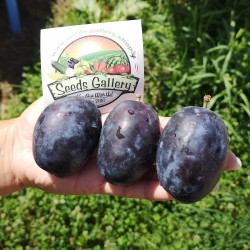
Giant Bosnian Plum Seeds...
Price
€2.55
SKU: V 197 BS
Seeds Gallery Com,
5/
5
<h2><strong>Giant Bosnian Plum Seeds (Prunus domestica)</strong></h2>
<h2><span style="color: #ff0000;" class=""><strong>Price for Package of 5 (6,5g) seeds.</strong></span></h2>
<p>This variety is from Bosnia, and very resistant to diseases. We came across this plum by chance at a farmer's yard and were immediately amazed by both the size and taste of this variety.</p>
<p>Unfortunately, the owner did not know what the name of the variety was, he only knew how to tell us that this plum variety was planted by his great-grandfather and that since then this plum has been kept and planted regularly so that this variety spreads and preserves as much as possible.</p>
<p>We asked him how this plum tolerates winter and low temperatures, and he answered that the temperature in their village drops to minus 24 degrees Celsius, and this was no problem for this plum.</p>
<p>The fruits are really huge and weigh an average of 70 to 85 grams per fruit.</p>
<p>A plum is a fruit of the subgenus Prunus of the genus Prunus. The subgenus is distinguished from other subgenera (peaches, cherries, bird cherries, etc.) in the shoots having terminal bud and solitary side buds (not clustered), the flowers in groups of one to five together on short stems, and the fruit having a groove running down one side and a smooth stone (or pit).</p>
<p>Mature plum fruit may have a dusty-white waxy coating that gives them a glaucous appearance. This is an epicuticular wax coating and is known as "wax bloom". Dried plum fruits are called dried plums or prunes, although, in American English, prunes are a distinct type of plum, and may have pre-dated the fruits now commonly known as plums.</p>
<p>Typically it forms a large shrub or a small tree. It may be somewhat thorny, with white blossom, borne in early spring. The oval or spherical fruit varies in size, but can be up to 8 cm across, and is usually sweet (dessert plum), though some varieties are sour and require cooking with sugar to make them palatable. Like all Prunus fruits, it contains a single large seed, usually called a stone, which is discarded when eating.</p>
<p>Plums are grown commercially in orchards, but modern rootstocks, together with self-fertile strains, training and pruning methods, allow single plums to be grown in relatively small spaces. Their early flowering and fruiting means that they require a sheltered spot away from frosts and cold winds.</p>
<p><strong>Cultivation and uses</strong></p>
<p>The taste of the plum fruit ranges from sweet to tart; the skin itself may be particularly tart. It is juicy and can be eaten fresh or used in jam-making or other recipes. Plum juice can be fermented into plum wine. In central England, a cider-like alcoholic beverage known as plum jerkum is made from plums.</p>
<p>Dried plums (or prunes) are also sweet and juicy and contain several antioxidants. Plums and prunes are known for their laxative effect. This effect has been attributed to various compounds present in the fruits, such as dietary fiber, sorbitol,[7] and isatin.[8] Prunes and prune juice are often used to help regulate the functioning of the digestive system. Dried prune marketers in the US have, in recent years, begun marketing their product as "dried plums". This is due to "prune" having negative connotations connected with elderly people suffering from constipation.</p>
<p>Dried, salted plums are used as a snack, sometimes known as saladito or salao. Various flavors of dried plum are available at Chinese grocers and specialty stores worldwide. They tend to be much drier than the standard prune. Cream, ginseng, spicy, and salty are among the common varieties. Licorice is generally used to intensify the flavor of these plums and is used to make salty plum drinks and toppings for shaved ice or baobing.</p>
<p>Pickled plums are another type of preserve available in Asia and international specialty stores. The Japanese variety, called umeboshi, is often used for rice balls, called onigiri or omusubi. The ume, from which umeboshi are made, is more closely related, however, to the apricot than to the plum.</p>
<p>As with many other members of the rose family, plum seeds contain cyanogenic glycosides, including amygdalin.[10] These substances are capable of decomposing into a sugar molecule and hydrogen cyanide gas. While plum seeds are not the most toxic within the rose family (the bitter almond is the most toxic[citation needed]), large doses of these chemicals from any source are hazardous to human health. On the other hand, plums are considered a source of phytochemical compounds with beneficial effects on health.</p>
<p>Prune kernel oil is made from the fleshy inner part of the pit of the plum.</p>
<p>Plums come in a wide variety of colours and sizes. Some are much firmer-fleshed than others, and some have yellow, white, green or red flesh, with equally varying skin colour.</p>
<p>Though not available commercially, the wood of plum trees is used by hobbyists and other private woodworkers for musical instruments, knife handles, inlays, and similar small projects.</p>
<p>When it flowers in the early spring, a plum tree will be covered in blossoms, and in a good year approximately 50% of the flowers will be pollinated and become plums. Flowering starts after 80 growing degree days.</p>
<p>If the weather is too dry, the plums will not develop past a certain stage, but will fall from the tree while still tiny, green buds, and if it is unseasonably wet or if the plums are not harvested as soon as they are ripe, the fruit may develop a fungal condition called brown rot. Brown rot is not toxic, and very small affected areas can be cut out of the fruit, but unless the rot is caught immediately, the fruit will no longer be edible. Plum is used as a food plant by the larvae of some Lepidoptera, including November moth, willow beauty and short-cloaked moth.</p>
<p><strong>The Serbian plum (Serbian: шљива / šljiva) is the third most produced in the world. In the Balkans, plum is converted into an alcoholic drink named slivovitz (plum brandy) (Serbian: шљивовица / šljivovica).</strong></p>
<p>A large number of plums, of the Damson variety, are also grown in Hungary, where they are called szilva and are used to make lekvar (a plum paste jam), palinka (traditional fruit brandy), plum dumplings, and other foods. The region of Szabolcs-Szatmár, in the northeastern part of the country near the borders with Ukraine and Romania, is a major producer of plums.</p>
<p>The plum blossom or meihua (Chinese: 梅花; pinyin: méihuā), along with the peony, are considered traditional floral emblems of China.</p>
<p>The plum is commonly used in China, Yunnan area, to produce a local plum wine with a smooth, sweet, fruity taste and approximately 12% alcohol by volume.</p>
<p> </p><script src="//cdn.public.n1ed.com/G3OMDFLT/widgets.js"></script>
V 197 BS (6,5g)


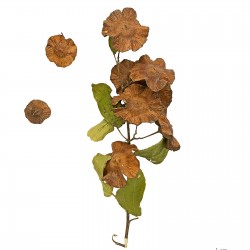
Jerusalem thorn, Christ's...
Price
€1.55
SKU: T 86
Seeds Gallery Com,
5/
5
<!DOCTYPE html>
<html>
<head>
<meta http-equiv="Content-Type" content="text/html; charset=UTF-8" />
</head>
<body>
<h2><strong>Jerusalem thorn, Christ's thorn Seeds (Paliurus spina-christi)</strong></h2>
<h2><span style="color: #f60303; font-size: 14pt;"><strong>Price for Package of 10 seeds.</strong></span></h2>
<p><i><b>Paliurus spina-christi</b></i><span>, commonly known as </span><b>Jerusalem thorn</b><span>, </span><b>garland thorn</b><span>, </span><b>Christ's thorn</b><span>, or </span><b>crown of thorns</b><span>, is a species of </span><i>Paliurus</i><span> native to the </span>Mediterranean region<span> and southwest and central </span>Asia<span>, from </span>Morocco<span> and </span>Spain<span> east to </span>Iran<span> and </span>Tajikistan<span>.</span></p>
<h2><span class="mw-headline" id="Description">Description</span></h2>
<p>It is a<span> </span>deciduous<span> </span>shrub<span> </span>or small<span> </span>tree<span> </span>growing to 3–4 m tall. The shoots are zig-zagged, with a<span> </span>leaf<span> </span>and two<span> </span>stipular<span> </span>spines<span> </span>(one straight, one curved) on the outside of each kink. The<span> </span>leaves<span> </span>are oval, 2–5 cm long and 1–4 cm broad, glossy green, with an entire margin. The<span> </span>fruit<span> </span>is a dry woody nutlet centered in a circular wing 2–3.5 cm diameter.</p>
<h2><span class="mw-headline" id="Etymology">Etymology</span></h2>
<p>As suggested by the Latin name and by an ancient oral tradition<sup class="noprint Inline-Template">[<i><span title="By whom? (May 2019)">clarification needed</span></i>]</sup>, the spiny branches of this shrub were supposedly used to make the<span> </span>crown of thorns<span> </span>placed on<span> </span>Christ's head before his crucifixion.<span> </span><i>Ziziphus spina-christi</i>, the Christ's thorn jujube, is also identified as being used for the crown of thorns.</p>
<h2><span class="mw-headline" id="Use">Use</span></h2>
<p>It is viewed as an ornamental curiosity and is cultivated in some areas, spreading its range, including Fiji.</p>
<p>As a medicinal herb (medicinal plant), the fruit of the bush is used, which contains alkaloids and tannins and is mostly appreciated for its anti-inflammatory and antiseptic, antispasmodic, expectorant, astringent and diuretic abilities.</p>
<p>Galen recommended it for bladder stones. The decoction of dried fruit (1 tablespoon / 500ml water, boil for 10 minutes and strain) is consumed for cough, asthma, diarrhea, hypertension, cleansing the blood of inflammation. Combines perfectly with common flaxseed (Linum), linden (Tília cordáta), prímula véris, Plantágo major, Salvia officinalis, Malva sylvestris and asthma acute) bronchitis. It is thought to have a laxative effect on the large intestine while fighting deforming arthritis - which is why it is often consumed by the elderly. Externally it seems to help especially in the treatment of eczema foci thanks to its anti-inflammatory action.</p>
<p>Note: The above presentation of the plant is by no means a recipe. Expert advice is considered necessary before using the plant.</p>
</body>
</html>
T 86


Bosnia and Herzegovina variety
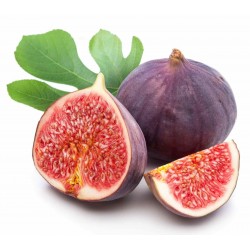
Wild Fig Seeds (from...
Price
€1.85
SKU: V 19 WF
Seeds Gallery Com,
5/
5
<!DOCTYPE html>
<html>
<head>
<meta http-equiv="Content-Type" content="text/html; charset=UTF-8" />
</head>
<body>
<h2><strong>Wild Fig Seeds (from Herzegovina)</strong></h2>
<h2><span style="color: #ff0000;"><strong>Price for Package of 20 seeds.</strong></span></h2>
<p>We brought this fig from Herzegovina and we found it in the mountains in complete wilderness. Its habitat was rocky and dry, which means that it is resistant to poor soil conditions. There are also constant droughts in that part and despite the fact that the plant did not get much water, it did not bother it to grow at all. The fruits are smaller than other varieties of figs and dark purple when ripe. Although the fruits are small they are very tasty and sweet. From reliable sources, we learned that where we took it, the temperature dropped to -15C in winter.</p>
<p>Fig flowers are difficult to spot because they grow inside figs and such flowers are pollinated by the so-called. fig wasps, which develop in the fruits of the wild fig. The difference between a tame and a wild fig is that the tame fig blooms only with female flowers while the wild fig has female and male flowers.</p>
<p>Wild figs grow at an abnormal rate compared to tame ones.</p>
</body>
</html>
V 19 WF (20 S)

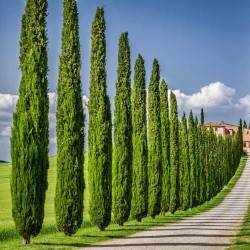
Mediterranean cypress Seeds...
Price
€1.75
SKU: T 16 CS
Seeds Gallery Com,
5/
5
<h2 class=""><strong>Mediterranean cypress Seeds (Cupressus sempervirens)</strong></h2>
<h2><span style="color: #f80000;"><strong>Price for Package of 0.5 g (about 50 seeds).</strong></span></h2>
<p class=""></p>
<p><i><b>Cupressus sempervirens</b></i>, the<span> </span><b>Mediterranean cypress</b><span> </span>(also known as<span> </span><b>Italian cypress</b>,<sup id="cite_ref-BSBI07_1-0" class="reference"></sup><span> </span><b>Tuscan cypress</b>,<span> </span><b>Persian cypress</b>, or<span> </span><b>pencil pine</b>), is a<span> </span>species<span> </span>of<span> </span>cypress<span> </span>native<span> </span>to the eastern<span> </span>Mediterranean region, in northeast<span> </span>Libya, southern<span> </span>Albania, southern and coastal<span> </span>Bulgaria, southern coastal<span> </span>Croatia, southern<span> </span>Montenegro, southern<span> </span>Bosnia and Herzegovina, southern<span> </span>Greece, southern<span> </span>Turkey,<span> </span>Cyprus,<span> </span>northern Egypt, western<span> </span>Syria,<span> </span>Lebanon,<span> </span>Malta,<span> </span>Italy,<span> </span>Palestine,<span> </span>Israel, western<span> </span>Jordan, South<span> </span>Caucasus, and also a<span> </span>disjunct population<span> </span>in<span> </span>Iran.</p>
<p><i>Cupressus sempervirens</i><span> </span>is a medium-sized<span> </span>coniferous<span> </span>evergreen<span> </span>tree<span> </span>to 35 m (115 ft) tall, with a conic crown with level branches and variably loosely hanging branchlets.<sup id="cite_ref-2" class="reference">[2]</sup><span> </span>It is very long-lived, with some trees reported to be over 1,000 years old.</p>
<p>The foliage grows in dense sprays, dark green in colour. The leaves are scale-like, 2–5 mm long, and produced on rounded (not flattened) shoots. The seed<span> </span>cones<span> </span>are ovoid or oblong, 25–40 mm long, with 10-14 scales, green at first, maturing brown about 20–24 months after pollination. The male cones are 3–5 mm long, and release pollen in late winter. It is moderately susceptible to<span> </span>cypress canker, caused by the fungus<span> </span><i>Seiridium<span> </span>cardinale</i>, and can suffer extensive<span> </span>dieback<span> </span>where this disease is common. The species name<span> </span><i>sempervirens</i><span> </span>comes from the Latin for 'evergreen'.</p>
<h2><span class="mw-headline" id="Uses">Uses</span></h2>
<p>Mediterranean cypress has been widely cultivated as an ornamental tree for millennia away from its native range, mainly throughout the whole Mediterranean region, and in other areas with similar hot, dry summers and mild, rainy winters, including California, southwest South Africa and southern Australia. It can also be grown successfully in areas with cooler, moister summers, such as the British Isles, New Zealand and the Pacific Northwest (coastal Oregon, Washington and British Columbia). It is also planted in Florida and parts of the coastal southern United States as an<span> </span>ornamental tree. In some areas, particularly the United States, it is known as "Italian" or "Tuscan cypress".</p>
<p>The vast majority of the trees in cultivation are selected<span> </span>cultivars<span> </span>with a<span> </span>fastigiate<span> </span>crown, with erect branches forming a narrow to very narrow crown often less than a tenth as wide as the tree is tall. The dark green "exclamation mark" shape of these trees is a highly characteristic signature of Mediterranean town and village landscapes. Formerly, the species was sometimes separated into two<span> </span>varieties, the wild<span> </span><i>C. sempervirens</i><span> </span>var.<span> </span><i>sempervirens</i><span> </span>(syn. var.<span> </span><i>horizontalis</i>), and the fastigiate<span> </span><i>C. s.</i><span> </span>var.<span> </span><i>pyramidalis</i><span> </span>(syn. var.<span> </span><i>fastigiata</i>, var.<span> </span><i>stricta</i>), but the latter is now only distinguished as a<span> </span>Cultivar Group, with no botanical significance.</p>
<p>It is also known for its very durable, scented<span> </span>wood, used most famously for the doors of<span> </span>St. Peter's Basilica<span> </span>in the<span> </span>Vatican City, Rome. Cypress used to be used in distilleries as<span> </span>staves<span> </span>to hold<span> </span>mash<span> </span>ferments to make alcohol before the invention of stainless steel. Commonly seen throughout<span> </span>New Mexico, the Mediterranean cypress is also known as the "drama tree" because of its tendency to bend with even the slightest of breezes.</p>
<p>In cosmetics it is used as<span> </span>astringent, firming,<span> </span>anti-seborrheic, anti-dandruff, anti-aging and as fragrance.<sup id="cite_ref-Carrasco_3-0" class="reference"></sup><span> </span>It is also the traditional wood used for Italian harpsichords.</p>
<h2><span class="mw-headline" id="Iran's_ancient_cypresses">Iran's ancient cypresses</span></h2>
<p>Cypress,<span> </span><i>Cupressus sempervirens</i>, was the first choice for Iranian Gardens. In all of the famous<span> </span>Persian Gardens, such as<span> </span>Fin Garden,<span> </span>Shazdeh Garden, Dowlat-Abad, and others, this tree plays a central role in their design.<sup class="noprint Inline-Template Template-Fact">[<i><span title="This claim needs references to reliable sources. (November 2011)">citation needed</span></i>]</sup><span> </span>The oldest living Cypress is the<span> </span>Sarv-e-Abarkooh<span> </span>in Iran's<span> </span>Yazd Province. Its age is estimated to be approximately 4,000 years.<sup id="cite_ref-5" class="reference"></sup></p>
<h2><span class="mw-headline" id="Symbolism">Symbolism</span></h2>
<p>In<span> </span>classical antiquity, the cypress was a symbol of mourning and in the modern era it remains the principal<span> </span>cemetery<span> </span>tree in both the Muslim world and Europe. In the classical tradition, the cypress was associated with death and<span> </span>the underworld<span> </span>because it failed to regenerate when cut back too severely.<span> </span>Athenian<span> </span>households in mourning were garlanded with boughs of cypress.<sup id="cite_ref-6" class="reference">[6]</sup><span> </span>Cypress was used to fumigate the air during<span> </span>cremations.<sup id="cite_ref-7" class="reference">[7]</sup><span> </span>It was among the plants that were suitable for making wreaths to adorn statues of<span> </span>Pluto, the<span> </span>classical<span> </span>ruler of the underworld.<sup id="cite_ref-8" class="reference"></sup></p>
<p>The poet<span> </span>Ovid, who wrote during the reign of<span> </span>Augustus, records the best-known myth that explains the association of the cypress with grief. The handsome boy<span> </span>Cyparissus, a favorite of<span> </span>Apollo, accidentally killed a beloved tame stag. His grief and remorse were so inconsolable that he asked to weep forever. He was transformed into<span> </span><i>cupressus sempervirens</i>, with the tree's sap as his tears.<sup id="cite_ref-9" class="reference">[9]</sup><span> </span>In another version of the story, it was the woodland god<span> </span>Silvanus<span> </span>who was the divine companion of Cyparissus and who accidentally killed the stag. When the boy was consumed by grief, Silvanus turned him into a tree, and thereafter carried a branch of cypress as a symbol of mourning.<sup id="cite_ref-10" class="reference"></sup></p>
<p>In Greek mythology, besides Cyparissus, the cypress is also associated with<span> </span>Artemis<span> </span>and<span> </span>Hecate, a goddess of magic, crossroads and the underworld. Ancient Roman funerary rites used it extensively.<sup class="noprint Inline-Template Template-Fact">[<i><span title="This claim needs references to reliable sources. (July 2019)">citation needed</span></i>]</sup></p>
<p>The most famous Muslim cemetery in Turkey where<span> </span><i>C. sempervirens</i><span> </span>is used widely is Istanbul<span> </span>Karacaahmet Cemetery. In<span> </span>Istanbul Turkish<span> </span>the tree is referred to as "Mezarlık Selvisi" (Cemetery Tree); its common name in Turkish and the name used in Turkish forestry is "Kara Selvi" (Black Cypress). Cypresses are mentioned extensively in the<span> </span><i>Shahnameh</i>, the great Iranian<span> </span>epic poem<span> </span>by<span> </span>Ferdowsi.<sup class="noprint Inline-Template Template-Fact">[<i><span title="This claim needs references to reliable sources. (July 2019)">citation needed</span></i>]</sup></p>
<p>In Jewish tradition, the cypress was held to be the wood used to build Noah's Ark and The Temple, and is mentioned as an idiom or metaphor in biblical passages, either referencing the tree's shape as an example of uprightness or its evergreen nature as an example of eternal beauty or health. It is popular in modern Israeli cemeteries, with contemporary explanation being that its shape resembles a candle and its being an evergreen symbolized the immortality of the soul.<sup class="noprint Inline-Template Template-Fact">[<i><span title="This claim needs references to reliable sources. (July 2019)">citation needed</span></i>]</sup></p>
<p>In popular culture the Italian cypress is often stereotypically associated with vacation destinations to the Mediterranean region; Italy in particular. The tree has been seen on travel posters for decades.</p>
<h2><span class="mw-headline" id="Other_characteristics">Other characteristics</span></h2>
<p>In July 2012, a forest fire, lasting five days, devastated 20,000 hectares of forest in the Valencian village of<span> </span>Andilla. However, amid the charred landscape, a group of 946 cypress trees about 22 years old was virtually unharmed, and only 12 cypresses were burned. Andilla cypresses were planted by the CypFire European project studying various aspects of the cypresses, including fire resistance.</p>
<script src="//cdn.public.n1ed.com/G3OMDFLT/widgets.js"></script>
T 16 CS (0,5g)


This plant is resistant to winter and frost.

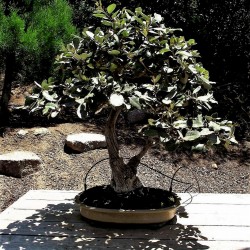
Silverberry wolf-willow...
Price
€2.25
SKU: T 39 EC
Seeds Gallery Com,
5/
5
<!DOCTYPE html>
<html>
<head>
<meta http-equiv="Content-Type" content="text/html; charset=UTF-8" />
</head>
<body>
<h2><strong>Silverberry wolf-willow seeds (Elaeagnus commutata)</strong></h2>
<h2><span style="color: #ff0000;"><strong>Price for Package of 5 seeds.</strong></span></h2>
<p><i><b>Elaeagnus commutata</b></i>, the<span> </span><b>silverberry</b><sup id="cite_ref-1" class="reference"></sup><span> </span>or<span> </span><b>wolf-willow</b>, is a species of<span> </span><i>Elaeagnus</i><span> </span>native to western and boreal<span> </span>North America, from southern<span> </span>Alaska<span> </span>through<span> </span>British Columbia<span> </span>east to<span> </span>Quebec, south to<span> </span>Utah, and across the upper<span> </span>Midwestern United States<span> </span>to<span> </span>South Dakota<span> </span>and western<span> </span>Minnesota.<sup id="cite_ref-grin_2-0" class="reference"></sup><sup id="cite_ref-3" class="reference"></sup><span> </span>It typically grows on dry to moist sandy and gravel soils in steppes, meadows or woodland edges.<sup id="cite_ref-bc_4-0" class="reference"></sup></p>
<p>These plants are<span> </span>shrubs<span> </span>or small<span> </span>trees<span> </span>growing to 1–4 m tall. The<span> </span>leaves<span> </span>are broad lanceolate, 2–7 cm long, silvery on both sides with dense small white scales. The fragrant<span> </span>flowers<span> </span>are yellow, with a four-lobed corolla 6–14 mm long. The<span> </span>fruits<span> </span>are ovoid<span> </span>drupes<span> </span>9–12 mm long, also covered in silvery scales. The fruit pulp is floury in texture and surrounds the single<span> </span>seed.<sup id="cite_ref-bc_4-1" class="reference"></sup></p>
<p>The species is cultivated as an<span> </span>ornamental plant<span> </span>for its silvery foliage.</p>
<p>Both the fruit and seeds of this plant are edible either cooked or raw. The fruit is very astringent unless it is fully ripe. The fruit is a very rich source of vitamins and minerals especially A, C, and E. As well it is a fairly good source of essential fatty acids. These fats are rarely found in fruits.<sup id="cite_ref-pfaf.org_5-0" class="reference"></sup><span> </span>This plant, like legumes, is able to fix nitrogen. When grown in orchards as a companion plant, it has been documented to increase fruit production by ten percent. Traditionally the fibrous bark of this tree has been twisted to make strong ropes and woven into clothing and blankets<span> </span><sup id="cite_ref-pfaf.org_5-1" class="reference"></sup></p>
<p>Sharp-tailed grouse and songbirds eat the fruits.<sup id="cite_ref-6" class="reference"></sup><span> </span>This plant is a food source for sharp-tailed grouse in the winter.<sup id="cite_ref-7" class="reference"></sup><span> </span>Silverberry is an important food for wildlife and it provides over one-quarter of the diet for moose during winter in Montana. It also provides food for deer and elk. It provides cover and nesting sites for mallards and many passerine birds in North Dakota<sup id="cite_ref-8" class="reference"></sup><span> </span>"In rough fescue grasslands, silverberry at 1,000 stems per acre increases forage production."</p>
</body>
</html>
T 39 EC

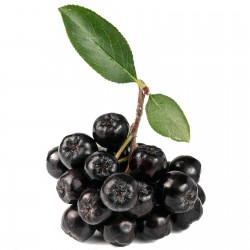
1000 Seeds Chokeberry...
Price
€11.00
SKU: V 29 (4g)
Seeds Gallery Com,
5/
5
<h2><strong>1000 Seeds Chokeberry (Aronia melanocarpa)</strong></h2>
<h2><span style="color: #ff0000;" class=""><strong>Price for Package of 1000 seeds.</strong></span></h2>
<p>Aronia melanocarpa is an extraordinary medicine plant that has been developed in Poland. It has an incredible array of health qualities. Known as Chokeberry, the native Americans used it to prepare pemmican (dried meat). It has a higher concentration of vitamin C than blackcurrants, but it also contains a host of other valuable substances, especially antioxidants, polyphenols, bioflavonoids, and tannins. It is a very hardy and vigorous plant and can survive most conditions.</p>
<h3><strong>Wikipedia</strong>:</h3>
<p><i><b>Aronia</b></i><span> </span>is a genus of<span> </span>deciduous<span> </span>shrubs, the<span> </span><b>chokeberries</b>, in the family<span> </span>Rosaceae<span> </span>native to eastern North America and most commonly found in wet woods and swamps.<span> </span>The genus is usually considered to contain two or three<span> </span>species, one of which is<span> </span>naturalized<span> </span>in Europe.</p>
<p>Chokeberries are cultivated as<span> </span>ornamental plants<span> </span>and as<span> </span>food products. The sour berries, or<span> </span><b>Aronia berries</b>, can be eaten raw off the bush, but are more frequently processed. They can be found in wine, jam, syrup, juice, soft spreads, tea, salsa,<span> </span>chili starters, extracts, beer, ice cream,<span> </span>gummies,<span> </span>and<span> </span>tinctures.<span> </span>The name "chokeberry" comes from the<span> </span>astringency<span> </span>of the fruits, which creates the sensation of making one's mouth pucker.</p>
<p><i>Chokeberries</i><span> </span>are often mistakenly called<span> </span><i>chokecherries</i>, the<span> </span>common name<span> </span>for<span> </span><i>Prunus virginiana</i>. Further adding to the ambiguity, a<span> </span>variety<span> </span>of<span> </span><i>Prunus virginiana</i><span> </span>is<span> </span><i>melanocarpa</i>,<sup id="cite_ref-9" class="reference">[9]</sup><span> </span>and readily confused with<span> </span><i>black chokeberry</i><span> </span>because it is commonly referred to as "black chokeberry" or "aronia". Aronia berries and chokecherries both contain<span> </span>polyphenolic<span> </span>compounds, such as<span> </span>anthocyanins, yet the two plants are distantly related within the family Rosaceae.</p>
<p>The<span> </span>leaves<span> </span>are alternate, simple, and<span> </span>oblanceolate<span> </span>with<span> </span>crenate<span> </span>margins and<span> </span>pinnate<span> </span>venation; in autumn the leaves turn a bold red color. Dark<span> </span>trichomes<span> </span>are present on the upper midrib surface. The<span> </span>flowers<span> </span>are small, with 5<span> </span>petals<span> </span>and 5<span> </span>sepals, and produced in<span> </span>corymbs<span> </span>of 10–25 together.<span> </span>Hypanthium<span> </span>is urn-shaped. The fruit is a small<span> </span>pome, with an<span> </span>astringent<span> </span>flavor.</p>
<p><i>Aronia</i><span> </span>has been thought to be closely related to<span> </span><i>Photinia</i>, and has been included in that genus in some classifications,<sup id="cite_ref-10" class="reference">[10]</sup><span> </span>but botanist Cornelis Kalkman observed that a combined genus should be under the older name<span> </span><i>Aronia</i>.<sup id="cite_ref-Kalkman_11-0" class="reference">[11]</sup><span> </span>The combined genus contains about 65 species.<sup id="cite_ref-weakley_12-0" class="reference">[12]</sup><span> </span>In 2004, Kalkman expressed doubt about the<span> </span>monophyly<span> </span>of the combined group, and new molecular studies confirm this.<sup id="cite_ref-Potter_13-0" class="reference">[13]</sup><sup id="cite_ref-Campbell_14-0" class="reference">[14]</sup><span> </span>They do not place these two genera together or even near one another.</p>
<p>In eastern North America are two well-known species, named after their fruit color, red chokeberry and black chokeberry, plus a purple chokeberry whose origin is a natural hybrid of the two.<sup id="cite_ref-weakley_12-1" class="reference">[12]</sup><span> </span>A fourth species,<span> </span><i>Aronia mitschurinii</i>, that apparently originated in cultivation, is also known as<span> </span><i>Sorbaronia mitschurinii</i>.</p>
<h2><span class="mw-headline" id="Cultivation">Cultivation</span></h2>
<p>Aronia is considered cold hardy and heat tolerant in<span> </span>USDA<span> </span>Zones 3 to 8.<sup id="cite_ref-usda_17-0" class="reference">[17]</sup><sup id="cite_ref-18" class="reference">[18]</sup><span> </span>Aronia plants grow well both in<span> </span>orchard-type rows or set as<span> </span>landscape<span> </span>elements, including several varieties in 3 to 12 foot heights.<sup id="cite_ref-usda_17-1" class="reference">[17]</sup></p>
<h3><span class="mw-headline" id="Products_and_uses">Products and uses</span></h3>
<p>The chokeberries are attractive<span> </span>ornamental plants<span> </span>for gardens. They are naturally understory and woodland edge plants, and grow well when planted under<span> </span>trees. Chokeberries are resistant to drought, insects, pollution, and disease. A number of<span> </span>cultivars, including<span> </span><i>A. arbutifolia</i><span> </span>'Brilliant' and<span> </span><i>A. melanocarpa</i><span> </span>'Autumn magic', have been selected for their striking fall leaf color.</p>
<p>An aronia wine is made in<span> </span>Lithuania. In<span> </span>Poland, aronia berries are added to jams and juices or dried to make a herbal<span> </span>tea<span> </span>sometimes blended with other ingredients, such as<span> </span>blackcurrant.<sup id="cite_ref-mckay_19-0" class="reference">[19]</sup><span> </span>In<span> </span>Bosnia and Herzegovina, the berries are sold fresh and frozen or made into juices, jams and teas.<sup id="cite_ref-Fresh_Fruit_Portal_20-0" class="reference">[20]</sup><span> </span>Aronia is also used as a<span> </span>flavoring<span> </span>or<span> </span>colorant<span> </span>for beverages or yogurts.<sup id="cite_ref-mckay_19-1" class="reference">[19]</sup><span> </span>Juice from the ripe berries is<span> </span>astringent, semi-sweet (moderate sugar content), sour (low<span> </span>pH), and contains a low level of<span> </span>vitamin C.<sup id="cite_ref-21" class="reference">[21]</sup><span> </span>The berries have a tart<span> </span>flavor<span> </span>and, in addition to juice, can be baked into breads.<sup id="cite_ref-mckay_19-2" class="reference">[19]</sup><span> </span>In the United States and Canada, aronia<span> </span>juice concentrate<span> </span>is used in manufactured juice blends.</p>
<h3><span class="mw-headline" id="Polyphenol_content">Polyphenol content</span></h3>
<p><i>Aronia melanocarpa</i><span> </span>(black chokeberry) has attracted scientific interest due to its deep purple, almost black<span> </span>pigmentation<span> </span>that arises from dense contents of<span> </span>polyphenols, especially<span> </span>anthocyanins. Total polyphenol content is 1752 mg per 100 g dry weight,<sup id="cite_ref-Phenol-Explorer_22-0" class="reference">[22]</sup><span> </span>anthocyanin content is 1480 mg per 100 g dry weight, and<span> </span>proanthocyanidin<span> </span>concentration is 664 mg per 100 g fresh weight.<sup id="cite_ref-Wu_23-0" class="reference">[23]</sup><sup id="cite_ref-24" class="reference">[24]</sup><span> </span>These values are among the highest measured in plants to date. The black aronia species contains higher levels of anthocyanins than purple (<i>Aronia prunifolia</i>) or red aronia (<i>Aronia arbutifolia</i>), whereas red and purple aronia are richer in phenolic acid and proanthocyanins.<sup id="cite_ref-pmid23941506_25-0" class="reference">[25]</sup></p>
<p>The plant produces these pigments mainly in the leaves and skin of the berries to protect the pulp and seeds from constant exposure to<span> </span>ultraviolet radiation<span> </span>and production of<span> </span>free radicals.<sup id="cite_ref-simon_26-0" class="reference">[26]</sup><sup id="cite_ref-27" class="reference">[27]</sup><sup id="cite_ref-28" class="reference">[28]</sup><span> </span>By absorbing<span> </span>UV<span> </span>rays in the<span> </span>blue-purple spectrum, leaf and skin pigments filter intense sunlight, serve antioxidant functions and thereby have a role assuring regeneration of the species. Brightly colorful pigmentation also attracts birds and other animals to consume the fruit and disperse the seeds in their droppings.<sup id="cite_ref-simon_26-1" class="reference">[26]</sup><sup id="cite_ref-29" class="reference">[29]</sup></p>
<p>Analysis of polyphenols in chokeberries has identified the following individual chemicals (among hundreds known to exist in the plant kingdom):<span> </span>cyanidin-3-galactoside, cyanidin-3-arabinoside,<span> </span>quercetin-3-glycoside,<span> </span>epicatechin,<span> </span>caffeic acid,<span> </span>delphinidin,<span> </span>petunidin,<span> </span>pelargonidin,<span> </span>peonidin, and<span> </span>malvidin.<sup id="cite_ref-Wu_23-1" class="reference">[23]</sup><sup id="cite_ref-pmid23941506_25-1" class="reference">[25]</sup><sup id="cite_ref-30" class="reference">[30]</sup><span> </span>All these except caffeic acid are members of the<span> </span>flavonoid<span> </span>category of phenolics.</p>
<p>For reference to phenolics, flavonoids, anthocyanins, and similar plant-derived phytochemicals,<sup id="cite_ref-Phenol-Explorer_22-1" class="reference">[22]</sup><span> </span>Wikipedia has a<span> </span>list of phytochemicals and foods in which they are prominent.</p>
<div>
<table border="1" cellspacing="0" cellpadding="0">
<tbody>
<tr>
<td colspan="2" valign="top" width="100%">
<p><span style="color: #008000;"><strong>Sowing Instructions</strong></span></p>
</td>
</tr>
<tr>
<td valign="top" nowrap="nowrap">
<p><span style="color: #008000;"><strong>Propagation:</strong></span></p>
</td>
<td valign="top">
<p><span style="color: #008000;">Seeds</span></p>
</td>
</tr>
<tr>
<td valign="top" nowrap="nowrap">
<p><span style="color: #008000;"><strong>Pretreat:</strong></span></p>
</td>
<td valign="top">
<p><span style="color: #008000;">soak in water for 8- 12 hours </span></p>
</td>
</tr>
<tr>
<td valign="top" nowrap="nowrap">
<p><span style="color: #008000;"><strong>Stratification:</strong></span></p>
</td>
<td valign="top">
<p><span style="color: #008000;">1 months in moist sowing mix at 2-5 ° C refrigerator</span></p>
</td>
</tr>
<tr>
<td valign="top" nowrap="nowrap">
<p><span style="color: #008000;"><strong>Sowing Time:</strong></span></p>
</td>
<td valign="top">
<p><span style="color: #008000;">all year round</span></p>
</td>
</tr>
<tr>
<td valign="top" nowrap="nowrap">
<p><span style="color: #008000;"><strong>Sowing Depth:</strong></span></p>
</td>
<td valign="top">
<p><span style="color: #008000;">1 cm</span></p>
</td>
</tr>
<tr>
<td valign="top" nowrap="nowrap">
<p><span style="color: #008000;"><strong>Sowing Mix:</strong></span></p>
</td>
<td valign="top">
<p><span style="color: #008000;">Coir or sowing mix + sand or perlite</span></p>
</td>
</tr>
<tr>
<td valign="top" nowrap="nowrap">
<p><span style="color: #008000;"><strong>Germination temperature:</strong></span></p>
</td>
<td valign="top">
<p><span style="color: #008000;">20 ° C</span></p>
</td>
</tr>
<tr>
<td valign="top" nowrap="nowrap">
<p><span style="color: #008000;"><strong>Location:</strong></span></p>
</td>
<td valign="top">
<p><span style="color: #008000;">bright + keep constantly moist not wet</span></p>
</td>
</tr>
<tr>
<td valign="top" nowrap="nowrap">
<p><span style="color: #008000;"><strong>Germination Time:</strong></span></p>
</td>
<td valign="top">
<p><span style="color: #008000;">2-8 weeks</span></p>
</td>
</tr>
<tr>
<td valign="top" nowrap="nowrap">
<p><span style="color: #008000;"><strong>Watering:</strong></span></p>
</td>
<td valign="top">
<p><span style="color: #008000;">Water regularly during the growing season</span></p>
</td>
</tr>
<tr>
<td valign="top" nowrap="nowrap">
<p><span style="color: #008000;"><strong> </strong></span></p>
</td>
<td valign="top">
<p><br><span style="color: #008000;"><em>Copyright © 2012 Seeds Gallery - Saatgut Galerie - Galerija semena. </em><em>All Rights Reserved.</em><em></em></span></p>
</td>
</tr>
</tbody>
</table>
</div>
<div>
<div style="text-align: center;">Genus: Aronia</div>
<div style="text-align: center;">Species: melanocarpa</div>
<div style="text-align: center;">Common Name: Black Chokeberry</div>
<div style="text-align: center;">Other Name: Chokeberry, Gueles Noires</div>
<div style="text-align: center;">Pre-treatment: required</div>
<div style="text-align: center;">Zone Hardiness Cold: 3</div>
<div style="text-align: center;">Zone Hardiness warm: 8</div>
<div style="text-align: center;">Plant Type: Small Shrub</div>
<div style="text-align: center;">Growth rate: medium</div>
<div style="text-align: center;">Vegetation type: deciduous</div>
<div style="text-align: center;">Leaf /Flower color: Green/White</div>
</div><script src="//cdn.public.n1ed.com/G3OMDFLT/widgets.js"></script>
V 29 (4g)


This plant is resistant to winter and frost.

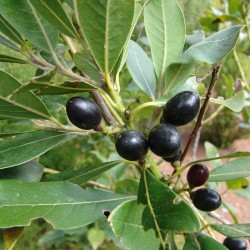
1000 Seeds Bay Laurel, bay...
Price
€95.00
SKU: MHS 83
Seeds Gallery Com,
5/
5
<meta http-equiv="Content-Type" content="text/html; charset=UTF-8" />
<h2><strong>1000 Seeds Bay Laurel, bay tree, true laurel (Laurus nobilis)</strong></h2>
<h2><span style="color: #ff0000;"><strong>Price for Package of 1000 seeds.</strong></span></h2>
<p><strong>We personally collect seeds every year in Bosnia and Herzegovina. The mother plants also withstood temperatures of -17 degrees Celsius.</strong></p>
<p>The bay laurel, with the botanical name Laurus nobilis, of the plant family Lauraceae, is also known as sweet bay, bay tree (esp. United Kingdom), true laurel, Grecian laurel, laurel tree, or simply laurel.</p>
<p>It is an aromatic evergreen tree or large shrub with green, glossy leaves, native to the Mediterranean region. It is one of the plants used for bay leaf seasoning in cooking. Under the simpler name "laurel," Laurus nobilis figures prominently in classical Greek, Roman, and Biblical culture.</p>
<p>Worldwide, many other kinds of plants in diverse families are also called "bay" or "laurel," generally due to similarity of foliage or aroma to Laurus nobilis, and the full name is used for the California bay laurel (Umbellularia), also in the family Lauraceae.</p>
<h2><strong>Characteristics</strong></h2>
<p>The laurel can vary greatly in size and height, sometimes reaching 10–18 metres (33–59 ft) tall. Laurus is a genus of evergreen trees belonging to the Laurel family, Lauraceae. The genus includes three species, whose diagnostic key characters often overlap (Mabberley 1997).</p>
<p>The laurel is dioecious (unisexual), with male and female flowers on separate plants. Each flower is pale yellow-green, about 1 cm diameter, and they are borne in pairs beside a leaf. The leaves are 6–12 cm long and 2–4 cm broad, with an entire (untoothed) margin. On some leaves the margin undulates. The fruit is a small, shiny black berry (a drupe, actually) about 1 cm long.</p>
<p>A recent study found considerable genetic diversity within L. nobilis, and that L. azorica is not genetically or morphologically distinct.</p>
<h2><strong>Ecology</strong></h2>
<p>Laurus nobilis is a widespread relic of the laurel forests that originally covered much of the Mediterranean Basin when the climate of the region was more humid. With the drying of the Mediterranean during the Pliocene era, the laurel forests gradually retreated, and were replaced by the more drought-tolerant sclerophyll plant communities familiar today. Most of the last remaining laurel forests around the Mediterranean are believed to have disappeared approximately ten thousand years ago, although some remnants still persist in the mountains of southern Turkey, northern Syria, southern Spain, north-central Portugal, northern Morocco, Canary Islands and in Madeira.</p>
<h3><strong>Chemical constituents</strong></h3>
<p>The most abundant essential oil found in laurel is cineole, also called eucalyptol.[2] The leaves contain about 1.3% essential oils (ol. lauri folii), consisting of 45% eucalyptol, 12% other terpenes, 3–4% sesquiterpenes, 3% methyleugenol, and other α- and β-pinenes, phellandrene, linalool, geraniol, and terpineol.</p>
<p>Both essential and fatty oils are present in the fruit. The fruit is pressed and water-extracted to obtain these products. The fruit contains up to 30% fatty oils and about 1% essential oils (terpenes, sesquiterpenes, alcohols, and ketones).</p>
<h2><strong>Food</strong></h2>
<p>The plant is the source of several popular herbs and one spice used in a wide variety of recipes, particularly among Mediterranean cuisines.[2] Most commonly, the aromatic leaves are added whole to Italian pasta sauces. However, even when cooked, whole bay leaves can be sharp and abrasive enough to damage internal organs, so they are typically removed from dishes before serving, unless used as a simple garnish.[4] Whole bay leaves have a long shelf life of about one year, under normal temperature and humidity.[4] Bay leaves are used almost exclusively as flavor agents during the food preparation stage;</p>
<p>Ground bay leaves, however, can be ingested safely and are often used in soups and stocks, as well as being a common addition to a Bloody Mary.[4] Dried laurel berries and pressed leaf oil can both be used as robust spices, and even the wood can be burnt for strong smoke flavoring.</p>
<h2><strong>Traditional medicine</strong></h2>
<p>Aqueous extracts of bay laurel can also be used as astringents and even as a reasonable salve for open wounds.</p>
<p>In massage therapy, the essential oil of bay laurel is reputed to alleviate arthritis and rheumatism, while in aromatherapy, it is used to treat earaches and high blood pressure.[6][unreliable source?] A traditional folk remedy for rashes caused by poison ivy, poison oak, and stinging nettle is a poultice soaked in boiled bay leaves.</p>
<p>The chemical compound lauroside B isolated from Laurus nobilis is an inhibitor of human melanoma (skin cancer) cell proliferation at high concentrations.</p>
<h2><strong>Other uses</strong></h2>
<p>Bay is widely cultivated as an ornamental plant in regions with Mediterranean or oceanic climates, and as a house plant or greenhouse plant in colder regions. It is used in topiary to create single erect stems with ball-shaped, box-shaped or twisted crowns; also for low hedges. Together with a gold form, L. nobilis 'Aurea',[9] it has gained the Royal Horticultural Society's Award of Garden Merit.[10]</p>
<p>Laurel oil is a main ingredient, and the distinguishing characteristic of Aleppo soap.</p>
<h3><strong>Symbolism</strong></h3>
<p>Bay laurel was used to fashion the laurel wreath of ancient Greece, a symbol of highest status. A wreath of bay laurels was given as the prize at the Pythian Games because the games were in honor of Apollo, and the laurel was one of his symbols.</p>
<p>Ovid tells the story in the Metamorphoses that laurel tree was first formed when the nymph Daphne was changed into a laurel tree because of Apollo's pursuit of her. Daphne is the Greek name for the tree.</p>
<p>The symbolism carried over to Roman culture, which held the laurel as a symbol of victory.[12] It is also the source of the words baccalaureate and poet laureate, as well as the expressions "assume the laurel" and "resting on one's laurels".</p>
<p>In the Bible, the laurel is often an emblem of prosperity and fame. In Christian tradition, it symbolizes the resurrection of Christ.</p>
<p style="text-align: left;">In Chinese folklore, there is a great laurel tree on the moon, and the Chinese name for the laurel, (Chinese: 月桂), literally translates to "moon-laurel". This is the subject of a story of Wu Gang, a man who aspired to immortality and neglected his work. When the deities discovered this, they sentenced Wu Gang to fell the laurel tree, whereupon he could join the ranks of the deities; however, since the laurel regenerated immediately when cut, it could never be felled. The phrase (Chinese: 吴刚伐木) ("Wu Gang chops the tree") is sometimes used to refer to endless toil, analogous to the legend of Sisyphus in Greek mythology</p>
<h2>How to Germinate Bay Leaf Seeds</h2>
<p><span>Commonly used in cooking and herbal treatments, bay leaves come from the bay laurel (Laurus nobilis) tree, which grows in U.S. Department of Agriculture hardiness zones 8 through 10. Attempting to grow bay laurel trees from seed can sometimes be frustrating as the seeds typically have a long germination period and may begin rotting before germination begins. It is possible to germinate bay laurel seeds, though it is recommended that you attempt to germinate multiple seeds at once to allow for germination failure and rotting in some of the seeds.</span></p>
<p><strong>Soak the bay laurel seeds in warm water for 24 hours.</strong></p>
<p><strong>2</strong></p>
<p>Prepare a seed tray with a layer of starting soil. The soil should be moist but not saturated and there should be no standing water present in the tray.</p>
<p><strong>3</strong></p>
<p>Spread the seeds out over the tray, pressing them lightly into the moistened soil. The seeds should be approximately two inches apart to allow them room to spread out once they begin developing roots and shoots.</p>
<p><strong>4</strong></p>
<p>Cover the seeds with a thin layer of compost, mulch or horticultural sand. Spray the contents of the tray lightly with warm water to dampen the seed covering. As with the initial moistening of the soil, you only want to dampen the covering and not saturate it.</p>
<p><strong>5</strong></p>
<p>Place the seed tray in an area where it will receive up to eight hours of sunlight per day and will maintain a temperature of about 70 degrees Fahrenheit.</p>
<p><strong>6</strong></p>
<p>Moisten the seed tray as needed. You want the soil and the seed covering to remain moist, though being slightly on the dry side will not harm the seeds. It is better for the seeds to germinate in an environment that is only slightly moist than one that is saturated since the latter condition encourages rotting.</p>
<p><strong>7</strong></p>
<p>Check the progress of the seeds weekly. It may take as few as 10 days or as long as six months for the bay laurel seeds to begin germinating. If you notice any seeds that have begun to rot, remove them from the tray.</p>
<p><strong>8</strong></p>
<p>Transplant germinated seeds to pots or to a prepared location outdoors once leaves begin to appear.</p>
<p><strong>Tip</strong></p>
<p>Bay laurel trees can grow as tall as 40 feet outdoors but can also be trained to grow in a pot through regular pruning. Many growers prune even outdoor trees to keep them around 10 feet tall for easy harvesting of leaves.</p>
<p><strong>Warning</strong></p>
<p>Bay leaves can have sharp edges and may cause mouth or throat injuries if chopped and put into food. Leaves used in cooking should be whole or contained in packets made of cheesecloth or other materials so that they can be removed before serving.</p>
<p>
<script type="text/javascript"></script>
</p>
MHS 83 (500g)


This plant is resistant to winter and frost.

Bosnia and Herzegovina variety
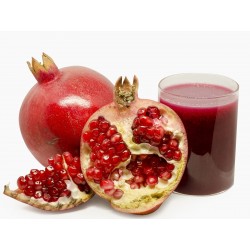
Pomegranate Seeds (Punica...
Price
€2.45
SKU: V 117 O
Seeds Gallery Com,
5/
5
<h2><strong>Pomegranate Seeds (Punica granatum)</strong></h2>
<h2><span style="color: #ff0000;" class=""><strong>Price for Package of 50 seeds.</strong></span></h2>
<p>The pomegranate /ˈpɒmɨɡrænɨt/, botanical name Punica granatum, is a fruit-bearing deciduous shrub or small tree growing between 5–8 meters (16–26 ft) tall.</p>
<p>The pomegranate is widely considered to have originated in the vicinity of Iran and has been cultivated since ancient times.[1][2][3] Today, it is widely cultivated throughout the Mediterranean region of southern Europe, the Middle East and Caucasus region, northern Africa and tropical Africa, the Indian subcontinent, Central Asia and the drier parts of southeast Asia.[4] Introduced into Latin America and California by Spanish settlers in 1769, pomegranate is also cultivated in parts of California and Arizona.</p>
<p>In the Northern Hemisphere, the fruit is typically in season from September to February.[6] In the Southern Hemisphere, the pomegranate is in season from March to May.</p>
<p>The pomegranate has been mentioned in many ancient texts, notably in Babylonian texts, the Book of Exodus, the Homeric Hymns and the Quran.[7] In recent years, it has become more common in the commercial markets of North America and the Western Hemisphere.</p>
<p>Pomegranates are used in cooking, baking, juices, smoothies and alcoholic beverages, such as martinis and wine.</p>
<h3><strong>Description</strong></h3>
<p>The Punica granatum leaves are opposite or sub-opposite, glossy, narrow oblong, entire, 3–7 cm long and 2 cm broad. The flowers are bright red, 3 cm in diameter, with four to five petals (often more on cultivated plants). Some fruitless varieties are grown for the flowers alone. The edible fruit is a berry and is between a lemon and a grapefruit in size, 5–12 cm in diameter with a rounded hexagonal shape, and has thick reddish skin. The exact number of seeds in a pomegranate can vary from 200 to about 1400 seeds, contrary to some beliefs that all pomegranates have exactly the same number of seeds.[9] Each seed has a surrounding water-laden pulp—the edible sarcotesta that forms from the seed coat—ranging in color from white to deep red or purple. The seeds are embedded in a white, spongy, astringent membrane.</p>
<h3><strong>Cultivation</strong></h3>
<p>Punica granatum is grown as a fruit crop plant, and as ornamental trees and shrubs in parks and gardens. Mature specimens can develop sculptural twisted bark multi-trunks and a distinctive overall form. Pomegranates are drought-tolerant, and can be grown in dry areas with either a Mediterranean winter rainfall climate or in summer rainfall climates. In wetter areas, they can be prone to root decay from fungal diseases. They can be tolerant of moderate frost, down to about −12 °C (10 °F).</p>
<p>Insect pests of the pomegranate can include the pomegranate butterfly Virachola isocrates and the leaf-footed bug Leptoglossus zonatus. Pomegranate grows easily from seed, but is commonly propagated from 25–50 cm hardwood cuttings to avoid the genetic variation of seedlings. Air layering is also an option for propagation, but grafting fails.</p>
<h3><strong>Varieties</strong></h3>
<p>Punica granatum var. nana is a dwarf variety of P. granatum popularly planted as an ornamental plant in gardens and larger containers, and used as a bonsai specimen tree. It could well be a wild form with a distinct origin. It has gained the Royal Horticultural Society's Award of Garden Merit.[12] The only other species in the genus Punica is the Socotran pomegranate (Punica protopunica), which is endemic to the island of Socotra. It differs in having pink (not red) flowers and smaller, less sweet fruit.[13] Scientists at Indian Institute of Horticultural Research, Bangalore, India, are in the process of developing disease resistant superior cultivars.</p>
<h3><strong>Cultivars</strong></h3>
<p>Punica granatum has more than 500 named cultivars, but the pomegranate evidently has considerable synonymy in which the same genotype is named differently across regions of the world.</p>
<p>Several characteristics between pomegranate genotypes vary for identification, consumer preference, preferred use, and marketing, the most important of which are fruit size, exocarp color (ranging from yellow to purple, with pink and red most common), seed-coat color (ranging from white to red), hardness of seed, maturity, juice content and its acidity, sweetness, and astringency.</p>
<h3><strong>Etymology</strong></h3>
<p>The name pomegranate derives from medieval Latin pōmum "apple" and grānātum "seeded".</p>
<p>This has influenced the common name for pomegranate in many languages (e.g. granada in Spanish, Granatapfel or Grenadine in German, grenade in French, granatäpple in Swedish, pomogranà in Venetian). Mālum grānātus, using the classical Latin word for apple, gives rise to the Italian name melograno, or less commonly melagrana.</p>
<p>Perhaps stemming from the old French word for the fruit, pomme-grenade, the pomegranate was known in early English as "apple of Grenada"—a term which today survives only in heraldic blazons. This is a folk etymology, confusing Latin granatus with the name of the Spanish city of Granada, which derives from Arabic.</p>
<p>The genus name Punica refers to the Phoenicians, who were active in broadening its cultivation, partly for religious reasons.</p>
<p>Garnet comes from Old French grenat by metathesis, from Medieval Latin granatum, here used in a different meaning: "of a dark red color". This meaning perhaps originated from pomum granatum because of the color of pomegranate pulp, or from granum in the sense of "red dye, cochineal".</p>
<p>The French term grenade for pomegranate has given its name to the military grenade.[19] Soldiers commented on the similar shape of early grenades and the name entered common usage.</p>
<p>While most European languages have cognate names for the fruit, stemming from Latin granatum, exceptions are the Armenian term nur, Albanian term "shega" and the Portuguese term romã which is derived from Arabic ruman, and has cognates in other Semitic languages (e.g. Hebrew rimmon) and Ancient Egyptian rmn.</p>
<h3><strong>Cultural history</strong></h3>
<p>The pomegranate is native to Persia (modern day Iran).[20] Pomegranates also thrive in the drier climates of California and Arizona, and have been cultivated in Iran, Iraq, Azerbaijan, Armenia, Afghanistan, Pakistan, India, Russia, Bangladesh and the Mediterranean region for several millennia.</p>
<p>Carbonized exocarp of the fruit has been identified in Early Bronze Age levels of Jericho in the West Bank, as well as Late Bronze Age levels of Hala Sultan Tekke on Cyprus and Tiryns.[citation needed] A large, dry pomegranate was found in the tomb of Djehuty, the butler of Queen Hatshepsut in Egypt; Mesopotamian cuneiform records mention pomegranates from the mid-Third millennium BC onwards.</p>
<p>It is also extensively grown in South China and in Southeast Asia, whether originally spread along the route of the Silk Road or brought by sea traders. Kandahar is famous in Afghanistan for its high quality pomegranates.</p>
<p>Although not native to Korea or Japan, the pomegranate is widely grown there and many cultivars have been developed. It is widely used for bonsai because of its flowers and for the unusual twisted bark that older specimens can attain.[24] The term "balaustine" (Latin: balaustinus) is also used for a pomegranate-red color.</p>
<p>Pomegranate cultivation in Italy is diffused throughout the southern region, especially in Olevano sul Tusciano and the rest of Campania's area. The ancient city of Granada in Spain was renamed after the fruit during the Moorish period. Spanish colonists later introduced the fruit to the Caribbean and Latin America, but in the English colonies it was less at home: "Don't use the pomegranate inhospitably, a stranger that has come so far to pay his respects to thee," the English Quaker Peter Collinson wrote to the botanizing John Bartram in Philadelphia, 1762. "Plant it against the side of thy house, nail it close to the wall. In this manner it thrives wonderfully with us, and flowers beautifully, and bears fruit this hot year. I have twenty-four on one tree... Doctor Fothergill says, of all trees this is most salutiferous to mankind."[26] The pomegranate had been introduced as an exotic to England the previous century, by John Tradescant the elder, but the disappointment that it did not set fruit there led to its repeated introduction to the American colonies, even New England. It succeeded in the South: Bartram received a barrel of pomegranates and oranges from a correspondent in Charleston, South Carolina, 1764. John Bartram partook of "delitious" pomegranates with Noble Jones at Wormsloe Plantation, near Savannah, Georgia, in September 1765. Thomas Jefferson planted pomegranates at Monticello in 1771: he had them from George Wythe of Williamsburg.</p>
<h3><strong>Culinary use</strong></h3>
<p>After the pomegranate is opened by scoring it with a knife and breaking it open, the seeds are separated from the peel and internal white pulp membranes. Separating the seeds is easier in a bowl of water because the seeds sink and the inedible pulp floats. Freezing the entire fruit also makes it easier to separate. Another very effective way of quickly harvesting the seeds is to cut the pomegranate in half, score each half of the exterior rind four to six times, hold the pomegranate half over a bowl and smack the rind with a large spoon. The seeds should eject from the pomegranate directly into the bowl, leaving only a dozen or more deeply embedded seeds to remove.[28]</p>
<p>The entire seed is consumed raw, though the watery, tasty sarcotesta is the desired part. The taste differs depending on the subspecies of pomegranate and its ripeness.</p>
<p>The pomegranate juice can be very sweet or sour, but most fruits are moderate in taste, with sour notes from the acidic tannins contained in the juice. Pomegranate juice has long been a popular drink in Armenian, Persian and Indian cuisine, and began to be widely distributed in the United States and Canada in 2002.</p>
<p>Grenadine syrup consisted long ago in a thickened and sweetened pomegranate juice but nowadays it is only a salesname for an industrial syrup based on various shrub berries, citric acid and food coloring, mainly used in cocktail mixing. Before tomatoes (a New World fruit) arrived in the Middle East, pomegranate juice, molasses and vinegar were widely used in many Iranian foods, and are still found in traditional recipes such as fesenjān, a thick sauce made from pomegranate juice and ground walnuts, usually spooned over duck or other poultry and rice, and in ash-e anar (pomegranate soup).</p>
<p>Wild pomegranate seeds are used as a spice known as anardana (from Persian: anar + dana, pomegranate + seed), most notably in Indian and Pakistani cuisine, but also as a substitute for pomegranate syrup in Persian cuisine. Dried whole seeds can often be obtained in ethnic Indian subcontinent markets. These seeds are separated from the flesh, dried for 10–15 days and used as an acidic agent for chutney and curry preparation. Ground anardana is also used, which results in a deeper flavoring in dishes and prevents the seeds from getting stuck in teeth. Seeds of the wild pomegranate variety known as daru from the Himalayas are regarded as quality sources for this spice.</p>
<p>Dried pomegranate seed, found in some natural specialty food markets, still contain some residual water, maintaining a natural sweet and tart flavor. Dried seeds can be used in several culinary applications, such as trail mix, granola bars, or as a topping for salad, yogurt, or ice cream. Chocolate covered seeds may be added to desserts and baked items.</p>
<p>In the Caucasus, pomegranate is used mainly as juice.[32] In Azerbaijan, a sauce from pomegranate juice (narsharab) is usually served with fish[33] or tika kabab. In Turkey, pomegranate sauce (Turkish: nar ekşisi) is used as a salad dressing, to marinate meat, or simply to drink straight. Pomegranate seeds are also used in salads and sometimes as garnish for desserts such as güllaç.[34] Pomegranate syrup or molasses is used in muhammara, a roasted red pepper, walnut, and garlic spread popular in Syria and Turkey.</p>
<p>In Greece, pomegranate (Greek: ρόδι, rodi) is used in many recipes, including kollivozoumi, a creamy broth made from boiled wheat, pomegranates and raisins, legume salad with wheat and pomegranate, traditional Middle Eastern lamb kebabs with pomegranate glaze, pomegranate eggplant relish, and avocado-pomegranate dip. Pomegranate is also made into a liqueur, and as a popular fruit confectionery used as ice cream topping, mixed with yogurt, or spread as jam on toast. In Cyprus and Greece, and among the Greek Orthodox Diaspora, ρόδι (Greek for pomegranate) is used to make koliva, a mixture of wheat, pomegranate seeds, sugar, almonds and other seeds served at memorial services.</p>
<p>In Mexico, they are commonly used to adorn the traditional dish chiles en nogada, representing the red of the Mexican flag in the dish which evokes the green (poblano pepper), white (nogada sauce) and red (pomegranate seeds) tricolor.</p>
<h3><strong>In Ayurvedic medicine</strong></h3>
<p>In the Indian subcontinent's ancient Ayurveda system of medicine, the pomegranate has extensively been used as a source of traditional remedies for thousands of years.</p>
<p>The rind of the fruit and the bark of the pomegranate tree is used as a traditional remedy against diarrhea, dysentery and intestinal parasites.[36] The seeds and juice are considered a tonic for the heart and throat, and classified as having bitter-astringent taste plus a range of taste from sweet to sour, depending on ripeneness. Thus Pomegranate is considered a healthful counterbalance to a diet high in sweet-fatty (kapha or earth) components.</p>
<p>Especially when sweet, pomegranate fruit is nourishing for (pitta or fire) systems, particularly the hemopoietic system, and is known as a blood builder. The astringent qualities of the flower juice, rind and tree bark are considered valuable for a variety of purposes, such as stopping nose bleeds and gum bleeds, toning skin, (after blending with mustard oil) firming-up sagging breasts and treating hemorrhoids.[38] Pomegranate juice (of specific fruit strains) is also used as eyedrops as it is believed to slow the development of cataracts.</p>
<p>Ayurveda differentiates between pomegranate varieties and employs them for different remedies.</p>
<p>Pomegranate has been used as a contraceptive and abortifacient by means of consuming the seeds, or rind, as well as by using the rind as a vaginal suppository. This practice is recorded in ancient Indian literature, in Medieval sources, and in modern folk medicine.</p>
<h3><strong>Nutrients and phytochemicals</strong></h3>
<p>Pomegranate seeds provide 12% of the Daily Value (DV) for vitamin C and 16% DV for vitamin K per 100 g serving, and contain polyphenols, such as ellagitannins and flavonoids (section below). Pomegranate seeds are excellent sources of dietary fiber which is entirely contained in the edible seeds. People who choose to discard the seeds forfeit nutritional benefits conveyed by the seed fiber and micronutrients.</p>
<h3><strong>Phenolic content</strong></h3>
<p>The most abundant polyphenols in pomegranate juice are the hydrolyzable tannins called ellagitannins formed when ellagic acid binds with a carbohydrate. Pomegranate ellagitannins, also called punicalagins, are tannins with free-radical scavenging properties in laboratory experiments and with potential human effects. Punicalagins are absorbed into the human body and may have dietary value as antioxidants, but conclusive proof of efficacy in humans has not been shown.</p>
<p> During intestinal metabolism by bacteria, ellagitannins and punicalagins are converted to urolithins, which have unknown biological activity in vivo. The different punicalagins present in P. granatum are granatin A and B, punicacortein A, B, C and D, 5-O-galloylpunicacortein D, punicafolin, punigluconin, punicalagin, 1-alpha-O-galloylpunicalagin, punicalin and 2-O-galloyl-punicalin.[citation needed] Other phenolics include catechins, gallocatechins, and anthocyanins, such as prodelphinidins, delphinidin, cyanidin, and pelargonidin.</p>
<p>Many food and dietary supplement makers use pomegranate phenolic extracts as ingredients in their products instead of the juice. One of these extracts is ellagic acid, which may become bioavailable only after parent molecule punicalagins are metabolized. However, ingested ellagic acid from pomegranate juice does not accumulate in the blood in significant quantities and is rapidly excreted. Accordingly, ellagic acid from pomegranate juice does not appear to be biologically important in vivo.</p>
<h3><strong>Potential health benefits</strong></h3>
<p>In preliminary laboratory research and clinical trials, juice of the pomegranate may be effective in reducing heart disease risk factors, including LDL oxidation, macrophage oxidative status, and foam cell formation.[52][53][54] In mice, "oxidation of LDL by peritoneal macrophages was reduced by up to 90% after pomegranate juice consumption...".</p>
<p>In a limited study of hypertensive patients, consumption of pomegranate juice for two weeks was shown to reduce systolic blood pressure by inhibiting serum angiotensin-converting enzyme.</p>
<p> Juice consumption may also inhibit viral infections while pomegranate extracts have antibacterial effects against dental plaque.</p>
<p>Despite limited research data, manufacturers and marketers of pomegranate juice have liberally used evolving research results for product promotion, especially for putative antioxidant health benefits. In February 2010, the FDA issued a Warning Letter to one such manufacturer, POM Wonderful, for using published literature to make illegal claims of unproven antioxidant and anti-disease benefits.</p>
<p><strong>Ancient Egypt</strong></p>
<p>Ancient Egyptians regarded the pomegranate as a symbol of prosperity and ambition. According to the Ebers Papyrus, one of the oldest medical writings from around 1500 BC, Egyptians used the pomegranate for treatment of tapeworm and other infections.</p>
<table border="1" cellspacing="0" cellpadding="0">
<tbody>
<tr>
<td colspan="2" valign="top" width="100%">
<p align="center"><span><strong>Sowing Instructions</strong></span></p>
</td>
</tr>
<tr>
<td valign="top" nowrap="nowrap">
<p align="center"><span><strong>Propagation:</strong></span></p>
</td>
<td valign="top">
<p align="center"><span>Seeds</span></p>
</td>
</tr>
<tr>
<td valign="top" nowrap="nowrap">
<p align="center"><span><strong>Pretreat:</strong></span></p>
</td>
<td valign="top">
<p align="center"><span>soak in water for 12-24 hours</span></p>
</td>
</tr>
<tr>
<td valign="top" nowrap="nowrap">
<p align="center"><span><strong>Stratification:</strong></span></p>
</td>
<td valign="top">
<p align="center"><span>0</span></p>
</td>
</tr>
<tr>
<td valign="top" nowrap="nowrap">
<p align="center"><span><strong>Sowing Time:</strong></span></p>
</td>
<td valign="top">
<p align="center"><span>all year round</span></p>
</td>
</tr>
<tr>
<td valign="top" nowrap="nowrap">
<p align="center"><span><strong>Sowing Depth:</strong></span></p>
</td>
<td valign="top">
<p align="center"><span>Needs Light to germinate! Just sprinkle on the surface of the substrate + gently press</span></p>
</td>
</tr>
<tr>
<td valign="top" nowrap="nowrap">
<p align="center"><span><strong>Sowing Mix:</strong></span></p>
</td>
<td valign="top">
<p align="center"><span>Coir or sowing mix + sand or perlite</span></p>
</td>
</tr>
<tr>
<td valign="top" nowrap="nowrap">
<p align="center"><span><strong>Germination temperature:</strong></span></p>
</td>
<td valign="top">
<p align="center"><span>10-15°C</span></p>
</td>
</tr>
<tr>
<td valign="top" nowrap="nowrap">
<p align="center"><span><strong>Location:</strong></span></p>
</td>
<td valign="top">
<p align="center"><span>bright + keep constantly moist not wet</span></p>
</td>
</tr>
<tr>
<td valign="top" nowrap="nowrap">
<p align="center"><span><strong>Germination Time:</strong></span></p>
</td>
<td valign="top">
<p align="center"><span>10 - 45 days</span></p>
</td>
</tr>
<tr>
<td valign="top" nowrap="nowrap">
<p align="center"><span><strong>Watering:</strong></span></p>
</td>
<td valign="top">
<p align="center"><span>Water regularly during the growing season</span></p>
</td>
</tr>
<tr>
<td valign="top" nowrap="nowrap"> </td>
<td valign="top">
<p align="center"><br /><span><em>Copyright © 2012 Seeds Gallery - Saatgut Galerie - Galerija semena. </em><em>All Rights Reserved.</em></span></p>
</td>
</tr>
</tbody>
</table>
<script src="//cdn.public.n1ed.com/G3OMDFLT/widgets.js"></script>
V 117 O (50 S)





